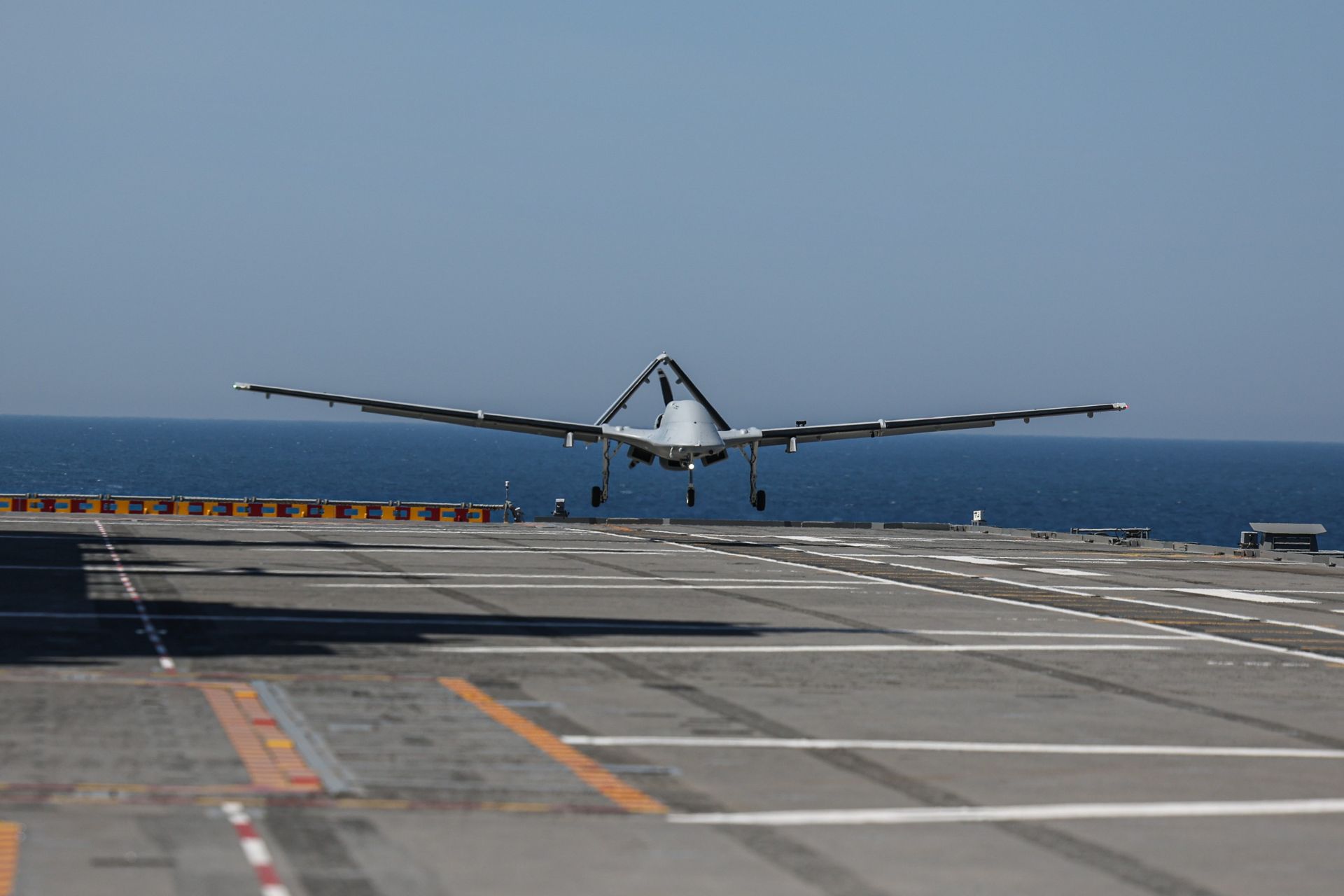Breaking News: Bayraktar TB3 Drone Confirms Naval Strike Capabilities with Four Successful Autonomous Flights from TCG Anadolu

{loadposition bannertop}
{loadposition sidebarpub}
On April 22, 2025, Turkish defense company Baykar reached a new milestone in naval aviation with its armed drone Bayraktar TB3, which carried out four autonomous sorties from the TCG Anadolu, sailing in the Gulf of Saros. These tests were part of the “Fully Autonomous Takeoff and Landing Tests from Short-Runway Vessel” campaign, aimed at validating the TB3’s ability to take off and land autonomously from a ship with a short runway.
Follow Army Recognition on Google News at this link
All four takeoffs and landings on the same day, including one performed at sunset, were executed with the support of artificial intelligence algorithms developed in-house by Baykar. (Picture source: Baykar)
This Turkish-designed combat drone, the first of its kind to demonstrate such a capability, once again confirmed its operational suitability for sea-based missions, operating without the aid of a landing assistance system. All four takeoffs and landings on the same day, including one performed at sunset, were executed with the support of artificial intelligence algorithms developed in-house by Baykar. These tests reinforce the TB3’s potential as an unmanned naval system capable of operating in constrained and complex maritime environments.
The Bayraktar TB3 has been developed by Baykar specifically for deployment from short-runway aircraft carriers, equipped with foldable wings and an autonomous takeoff and landing system. Its Line-of-Sight (LOS) and Beyond-Line-of-Sight (BLOS) communication capabilities allow for remote operation over very long distances, enabling it to perform intelligence, surveillance, reconnaissance, and strike missions. With a wingspan of 14 meters, a payload capacity of 280 kg, a maximum endurance exceeding 21 hours, and a service ceiling of 25,000 feet, the TB3 is configured for a broad range of modern naval air operations, including those conducted abroad.
Operationally versatile, the TB3 is designed to carry six precision-guided munitions, including laser-guided, INS/GPS-guided, infrared-guided, and air-to-air weapons. It is also compatible with a range of interchangeable ISR payloads, such as EO/IR systems with laser designators, multi-mode AESA radar, ELINT sensors, and sonobuoys. Powered by a 170-horsepower turbodiesel engine, the drone combines endurance, deployment flexibility, and strike capability, supporting naval forces in contested environments.
The TB3 first flew from the TCG Anadolu on November 19, 2024, off the coast of Aksaz, followed by a second round of successful flight tests on November 26 of the same year. To date, the drone has accumulated a total of 1,016 flight hours and 42 minutes. Among the most notable trials was the long-endurance flight conducted on December 20, 2023, during which the TB3 remained airborne for 32 hours and covered a distance of 5,700 kilometers, demonstrating significant endurance capability.
The drone has also participated in live-fire tests. On March 25 and 27, 2025, it deployed the UAV-122 supersonic missile developed by Roketsan to engage naval targets. The March 27 strike was particularly notable for targeting a 6-by-6-meter camouflaged structure at low altitude and beyond line of sight, with laser designation provided in-flight by another Turkish drone, the Bayraktar TB2. This test demonstrated the TB3’s ability to operate within a networked drone ecosystem and execute coordinated strikes.
From a technical standpoint, the TB3 is powered by the PD-170 engine, developed domestically by TEI. This engine enabled the drone to reach an altitude of 36,310 feet during a high-altitude performance test conducted on June 25, 2024, at Baykar’s test center in Keşan, Edirne province. Although this places the TB3 among the highest-performing drones in its class, the national altitude record remains with the Bayraktar AKINCI, which reached 45,118 feet.
The integration of domestically developed sensors has also progressed. On March 26, 2024, the TB3 flew for the first time with the ASELFLIR-500, an electro-optical reconnaissance, surveillance, and targeting system developed by ASELSAN. This system, designed to match or exceed the performance of its global counterparts, enhances the TB3’s ability to conduct ISR operations independently.
The Bayraktar TB3 has been developed by Baykar specifically for deployment from short-runway aircraft carriers, equipped with foldable wings and an autonomous takeoff and landing system (Picture source: Baykar)
Thanks to its foldable wing structure and BLOS communication capabilities, the TB3 is optimized for long-range missions from naval platforms. It is designed to perform reconnaissance, surveillance, targeting, and strike missions against overseas targets, contributing to the expansion of maritime deterrence capabilities.
The integration of a drone such as the Bayraktar TB3 aboard a short-runway vessel like the TCG Anadolu marks a significant shift in Turkish naval doctrine. By providing an uncrewed aerial strike and surveillance capability from the sea, this system enables extended operations without relying on conventional carrier groups or forward land bases. This becomes particularly valuable in restricted or contested areas, where the ability to deploy armed drones from sea platforms can provide immediate tactical advantages while reducing risk to personnel.
Strategically, the TB3 significantly broadens the operational reach of the Turkish Armed Forces. With its endurance, modular payloads, and ability to operate from austere maritime environments, it opens the door to missions such as maritime interdiction, preemptive strike, and persistent ISR in key areas like the Eastern Mediterranean, Aegean Sea, and Black Sea. In combination with other networked UAVs, the TB3 contributes to a distributed and resilient combat architecture, enhancing Türkiye’s ability to counter modern anti-access/area denial (A2/AD) threats and conduct long-range power projection.
Baykar has developed all of its systems using self-funded resources since launching its R&D programs in 2003. In both 2023 and 2024, the company recorded $1.8 billion in export revenue, representing 83% and 90% of its annual turnover, respectively. It ranks among Türkiye’s top ten exporters across all industries.
As a global leader in armed drone systems, Baykar has signed export agreements with 36 countries: 34 for the Bayraktar TB2 and 11 for the Bayraktar AKINCI. The company has been named Türkiye’s top defense and aerospace exporter for multiple years, accounting for one-third of the sector’s exports in 2023 and one-quarter in 2024. With the ongoing success of the TB3 aboard the TCG Anadolu, Baykar continues to position itself as a key player in shipborne unmanned aviation, advancing its strategy of domestic innovation and international expansion.
The Bayraktar TB3 thus emerges as a pivotal system in the evolution of Turkish naval air capabilities. Its recent performances illustrate its technological maturity and potential to equip naval forces with a UCAV system capable of autonomous operations from sea-based platforms. Through successful flight tests, domestically developed propulsion and sensors, and a well-established export presence, the TB3 strengthens Türkiye’s profile in the field of next-generation maritime drones.

{loadposition bannertop}
{loadposition sidebarpub}
On April 22, 2025, Turkish defense company Baykar reached a new milestone in naval aviation with its armed drone Bayraktar TB3, which carried out four autonomous sorties from the TCG Anadolu, sailing in the Gulf of Saros. These tests were part of the “Fully Autonomous Takeoff and Landing Tests from Short-Runway Vessel” campaign, aimed at validating the TB3’s ability to take off and land autonomously from a ship with a short runway.
All four takeoffs and landings on the same day, including one performed at sunset, were executed with the support of artificial intelligence algorithms developed in-house by Baykar. (Picture source: Baykar)
This Turkish-designed combat drone, the first of its kind to demonstrate such a capability, once again confirmed its operational suitability for sea-based missions, operating without the aid of a landing assistance system. All four takeoffs and landings on the same day, including one performed at sunset, were executed with the support of artificial intelligence algorithms developed in-house by Baykar. These tests reinforce the TB3’s potential as an unmanned naval system capable of operating in constrained and complex maritime environments.
The Bayraktar TB3 has been developed by Baykar specifically for deployment from short-runway aircraft carriers, equipped with foldable wings and an autonomous takeoff and landing system. Its Line-of-Sight (LOS) and Beyond-Line-of-Sight (BLOS) communication capabilities allow for remote operation over very long distances, enabling it to perform intelligence, surveillance, reconnaissance, and strike missions. With a wingspan of 14 meters, a payload capacity of 280 kg, a maximum endurance exceeding 21 hours, and a service ceiling of 25,000 feet, the TB3 is configured for a broad range of modern naval air operations, including those conducted abroad.
Operationally versatile, the TB3 is designed to carry six precision-guided munitions, including laser-guided, INS/GPS-guided, infrared-guided, and air-to-air weapons. It is also compatible with a range of interchangeable ISR payloads, such as EO/IR systems with laser designators, multi-mode AESA radar, ELINT sensors, and sonobuoys. Powered by a 170-horsepower turbodiesel engine, the drone combines endurance, deployment flexibility, and strike capability, supporting naval forces in contested environments.
The TB3 first flew from the TCG Anadolu on November 19, 2024, off the coast of Aksaz, followed by a second round of successful flight tests on November 26 of the same year. To date, the drone has accumulated a total of 1,016 flight hours and 42 minutes. Among the most notable trials was the long-endurance flight conducted on December 20, 2023, during which the TB3 remained airborne for 32 hours and covered a distance of 5,700 kilometers, demonstrating significant endurance capability.
The drone has also participated in live-fire tests. On March 25 and 27, 2025, it deployed the UAV-122 supersonic missile developed by Roketsan to engage naval targets. The March 27 strike was particularly notable for targeting a 6-by-6-meter camouflaged structure at low altitude and beyond line of sight, with laser designation provided in-flight by another Turkish drone, the Bayraktar TB2. This test demonstrated the TB3’s ability to operate within a networked drone ecosystem and execute coordinated strikes.
From a technical standpoint, the TB3 is powered by the PD-170 engine, developed domestically by TEI. This engine enabled the drone to reach an altitude of 36,310 feet during a high-altitude performance test conducted on June 25, 2024, at Baykar’s test center in Keşan, Edirne province. Although this places the TB3 among the highest-performing drones in its class, the national altitude record remains with the Bayraktar AKINCI, which reached 45,118 feet.
The integration of domestically developed sensors has also progressed. On March 26, 2024, the TB3 flew for the first time with the ASELFLIR-500, an electro-optical reconnaissance, surveillance, and targeting system developed by ASELSAN. This system, designed to match or exceed the performance of its global counterparts, enhances the TB3’s ability to conduct ISR operations independently.

The Bayraktar TB3 has been developed by Baykar specifically for deployment from short-runway aircraft carriers, equipped with foldable wings and an autonomous takeoff and landing system (Picture source: Baykar)
Thanks to its foldable wing structure and BLOS communication capabilities, the TB3 is optimized for long-range missions from naval platforms. It is designed to perform reconnaissance, surveillance, targeting, and strike missions against overseas targets, contributing to the expansion of maritime deterrence capabilities.
The integration of a drone such as the Bayraktar TB3 aboard a short-runway vessel like the TCG Anadolu marks a significant shift in Turkish naval doctrine. By providing an uncrewed aerial strike and surveillance capability from the sea, this system enables extended operations without relying on conventional carrier groups or forward land bases. This becomes particularly valuable in restricted or contested areas, where the ability to deploy armed drones from sea platforms can provide immediate tactical advantages while reducing risk to personnel.
Strategically, the TB3 significantly broadens the operational reach of the Turkish Armed Forces. With its endurance, modular payloads, and ability to operate from austere maritime environments, it opens the door to missions such as maritime interdiction, preemptive strike, and persistent ISR in key areas like the Eastern Mediterranean, Aegean Sea, and Black Sea. In combination with other networked UAVs, the TB3 contributes to a distributed and resilient combat architecture, enhancing Türkiye’s ability to counter modern anti-access/area denial (A2/AD) threats and conduct long-range power projection.
Baykar has developed all of its systems using self-funded resources since launching its R&D programs in 2003. In both 2023 and 2024, the company recorded $1.8 billion in export revenue, representing 83% and 90% of its annual turnover, respectively. It ranks among Türkiye’s top ten exporters across all industries.
As a global leader in armed drone systems, Baykar has signed export agreements with 36 countries: 34 for the Bayraktar TB2 and 11 for the Bayraktar AKINCI. The company has been named Türkiye’s top defense and aerospace exporter for multiple years, accounting for one-third of the sector’s exports in 2023 and one-quarter in 2024. With the ongoing success of the TB3 aboard the TCG Anadolu, Baykar continues to position itself as a key player in shipborne unmanned aviation, advancing its strategy of domestic innovation and international expansion.
The Bayraktar TB3 thus emerges as a pivotal system in the evolution of Turkish naval air capabilities. Its recent performances illustrate its technological maturity and potential to equip naval forces with a UCAV system capable of autonomous operations from sea-based platforms. Through successful flight tests, domestically developed propulsion and sensors, and a well-established export presence, the TB3 strengthens Türkiye’s profile in the field of next-generation maritime drones.






